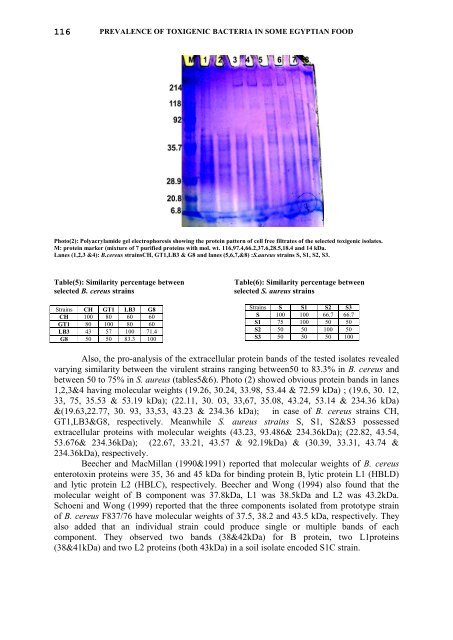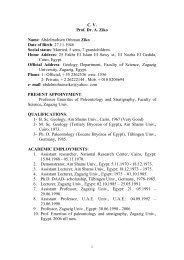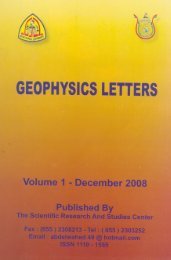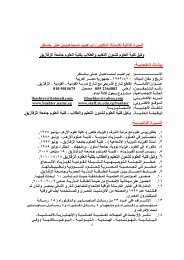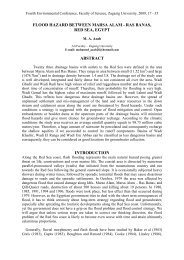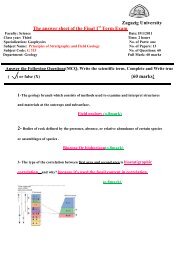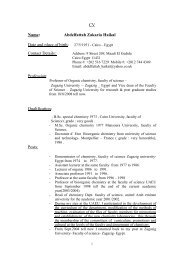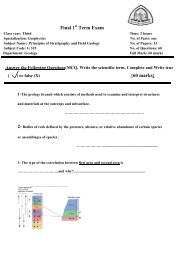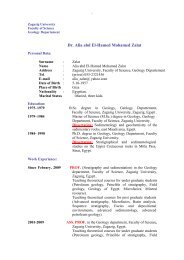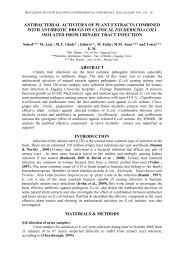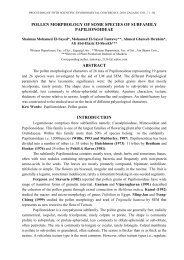prevalence of toxigenic bacteria in some egyptian food abstract ...
prevalence of toxigenic bacteria in some egyptian food abstract ...
prevalence of toxigenic bacteria in some egyptian food abstract ...
Create successful ePaper yourself
Turn your PDF publications into a flip-book with our unique Google optimized e-Paper software.
116PREVALENCE OF TOXIGENIC BACTERIA IN SOME EGYPTIAN FOODPhoto(2): Polyacrylamide gel electrophoresis show<strong>in</strong>g the prote<strong>in</strong> pattern <strong>of</strong> cell free filtrates <strong>of</strong> the selected <strong>toxigenic</strong> isolates.M: prote<strong>in</strong> marker (mixture <strong>of</strong> 7 purified prote<strong>in</strong>s with mol. wt. 116,97.4,66.2,37.6,28.5,18.4 and 14 kDa.Lanes (1,2,3 &4): B.cereus stra<strong>in</strong>sCH, GT1,LB3 & G8 and lanes (5,6,7,&8) :S.aureus stra<strong>in</strong>s S, S1, S2, S3.Table(5): Similarity percentage betweenselected B. cereus stra<strong>in</strong>sStra<strong>in</strong>s CH GT1 LB3 G8CH 100 80 60 60GT1 80 100 80 60LB3 43 57 100 71.4G8 50 50 83.3 100Table(6): Similarity percentage betweenselected S. aureus stra<strong>in</strong>sStra<strong>in</strong>s S S1 S2 S3S 100 100 66.7 66.7S1 75 100 50 50S2 50 50 100 50S3 50 50 50 100Also, the pro-analysis <strong>of</strong> the extracellular prote<strong>in</strong> bands <strong>of</strong> the tested isolates revealedvary<strong>in</strong>g similarity between the virulent stra<strong>in</strong>s rang<strong>in</strong>g between50 to 83.3% <strong>in</strong> B. cereus andbetween 50 to 75% <strong>in</strong> S. aureus (tables5&6). Photo (2) showed obvious prote<strong>in</strong> bands <strong>in</strong> lanes1,2,3&4 hav<strong>in</strong>g molecular weights (19.26, 30.24, 33.98, 53.44 & 72.59 kDa) ; (19.6, 30. 12,33, 75, 35.53 & 53.19 kDa); (22.11, 30. 03, 33,67, 35.08, 43.24, 53.14 & 234.36 kDa)&(19.63,22.77, 30. 93, 33,53, 43.23 & 234.36 kDa); <strong>in</strong> case <strong>of</strong> B. cereus stra<strong>in</strong>s CH,GT1,LB3&G8, respectively. Meanwhile S. aureus stra<strong>in</strong>s S, S1, S2&S3 possessedextracellular prote<strong>in</strong>s with molecular weights (43.23, 93.486& 234.36kDa); (22.82, 43.54,53.676& 234.36kDa); (22.67, 33.21, 43.57 & 92.19kDa) & (30.39, 33.31, 43.74 &234.36kDa), respectively.Beecher and MacMillan (1990&1991) reported that molecular weights <strong>of</strong> B. cereusenterotox<strong>in</strong> prote<strong>in</strong>s were 35, 36 and 45 kDa for b<strong>in</strong>d<strong>in</strong>g prote<strong>in</strong> B, lytic prote<strong>in</strong> L1 (HBLD)and lytic prote<strong>in</strong> L2 (HBLC), respectively. Beecher and Wong (1994) also found that themolecular weight <strong>of</strong> B component was 37.8kDa, L1 was 38.5kDa and L2 was 43.2kDa.Schoeni and Wong (1999) reported that the three components isolated from prototype stra<strong>in</strong><strong>of</strong> B. cereus F837/76 have molecular weights <strong>of</strong> 37.5, 38.2 and 43.5 kDa, respectively. Theyalso added that an <strong>in</strong>dividual stra<strong>in</strong> could produce s<strong>in</strong>gle or multiple bands <strong>of</strong> eachcomponent. They observed two bands (38&42kDa) for B prote<strong>in</strong>, two L1prote<strong>in</strong>s(38&41kDa) and two L2 prote<strong>in</strong>s (both 43kDa) <strong>in</strong> a soil isolate encoded S1C stra<strong>in</strong>.


